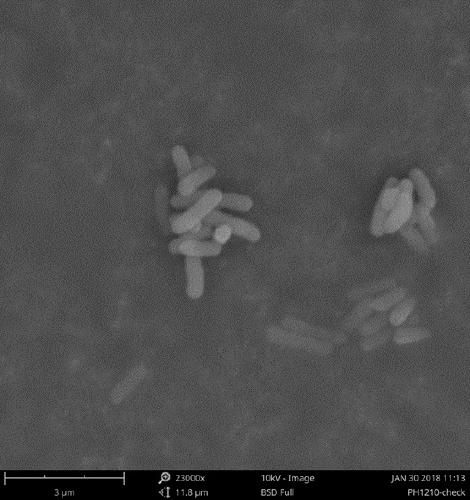Heat-resistant halomonas bacterium and application thereof
A technology of halophilic bacteria and moderate halophilic bacteria, applied in the direction of bacteria, microorganisms, biochemical equipment and methods, etc., can solve problems such as pollution, non-degradable, and environmental damage
- Summary
- Abstract
- Description
- Claims
- Application Information
AI Technical Summary
Problems solved by technology
Method used
Image
Examples
Embodiment 1
[0021] Embodiment one: Halomonas Halomonas Screening and isolation of sp. LCB169
[0022] The samples were collected from saline-alkali soil collected from Yumen Pass in Dunhuang, Gansu Province. Add 1 g of soil sample into a test tube filled with 9 mL of sterile water, vortex, then pipette 1 mL of the suspension into a test tube filled with 9 mL of sterile water, and prepare 10 -1 ~10 -6 Multiple times of the soil dilution suspension, pipette 100 μL and spread it on the screening medium plate, place it upside down at 37 °C and incubate for 72 hours, observe the growth status and morphological characteristics of the colony, pick a single colony with a sterile bamboo stick and transfer To fresh LB+10 % (w / v)NaCl (pH=8.0) solid medium for streak purification, cultivate under the same conditions, pick out a single colony and purify again, repeat several times, and finally pick a single colony for transfer To the slant of the purified medium, store at 4 °C for short-term stora...
Embodiment 2
[0026] Embodiment two: Halomonas Halomonas growth characteristics of sp. LCB169
[0027] Prepare LB liquid medium (pH=8.0) with NaCl concentration of 0%, 3%, 5%, 7%, 10%, 12%, 15%, 17% and 20% (w / v) respectively, each gradient Set up three parallels, quantitatively inoculate each test tube with fresh seed solution, place it on a shaker at 30°C and 180 rpm for 48 h, take it out and measure its OD 600 value, so as to determine the tolerance range and optimal growth concentration of its NaCl concentration; similarly, use the buffer system (pH 4.0–5.0: 0.1 M citric acid / 0.1 M sodiumcitrate; pH 6.0–8.0: 0.1 M KH 2 PO 4 / 0.1 M NaOH; pH 9.0–10.0: 0.1 M NaHCO 3 / 0.1 MNa 2 CO 3 ; pH 11.0: 0.05 M Na 2 HPO 4 / 0.1 M NaOH) to prepare LB+10 % (w / v) NaCl liquid medium with pH values of 4.0, 5.0, 6.0, 7.0, 8.0, 9.0, 10.0, 11.0, and analyze the pH tolerance range after inoculation and optimal growth pH; combined with the existing conditions of this experiment and comprehensively c...
Embodiment 3
[0028] Embodiment three: Halomonas Halomonas Analysis of enzymatic characteristics of sp. LCB169
[0029] Oxidase test: Add fresh reagent of 1 % (w / v) tetramethyl-p-phenylenediamine hydrochloride directly to a single colony in the exponential growth phase, if it turns purple within 10 s, it is oxidase Positive; on the contrary, if it changes color or does not change color for more than 60 s, it is oxidase negative.
[0030] Catalase experiment: the experimental strain was cultured in the solid medium of LB+10% (w / v) NaCl to the exponential growth phase, a little bacterium was picked and applied to a petri dish, and 5% hydrogen peroxide solution was added dropwise, Observe whether there are bubbles, if a large number of bubbles are produced within 30 s, it is catalase positive; otherwise, if no bubbles are produced, it is catalase negative.
[0031] Urease test: culture the experimental strains on LB+10% (w / v) NaCl medium plates for urease determination on the 3rd and 7th da...
PUM
 Login to View More
Login to View More Abstract
Description
Claims
Application Information
 Login to View More
Login to View More - R&D
- Intellectual Property
- Life Sciences
- Materials
- Tech Scout
- Unparalleled Data Quality
- Higher Quality Content
- 60% Fewer Hallucinations
Browse by: Latest US Patents, China's latest patents, Technical Efficacy Thesaurus, Application Domain, Technology Topic, Popular Technical Reports.
© 2025 PatSnap. All rights reserved.Legal|Privacy policy|Modern Slavery Act Transparency Statement|Sitemap|About US| Contact US: help@patsnap.com

